Good Time to Be Bond Investor
Posted On Friday, Dec 22, 2023
Year 2023 can be characterised as a year of great volatility. Throughout the year, global bond market was toggling between two opposing narratives - “persistent inflation” and “recession” – particularly in the United States. Central bankers’ data dependency and volatile economic data too kept bond markets at the edge.
Going into 2024, outlook for the bond market and the fixed income as an asset class has improved greatly. There are many reasons to be positive on the bond market. We shall discuss some of them in subsequent sections.
For starters, the rate hiking cycle has peaked and the rate cutting cycle is about to begin. Inflation is cooling off along with slowing global growth. High interest rates, declining growth and heightened geo-political tensions have increased the risk of financial or economic shocks.
Domestically, demand supply dynamics in the bond market is looking more favourable with robust tax collections, government’s fiscal consolidation plan and India’s inclusion in the global bond index.
Monetary Policy – Heading for Reversal
Heading into 2024, central banks’ tone has begun to shift. In contrast to its higher for longer message just two months back, the US Fed has now readied itself to talk about rate cuts.
More importantly, it doesn’t see recession as a pre-condition for rate cuts; “just a sign that the economy is normalizing and doesn’t need the tight policy” would be enough for the FED to move.
The Dot Plot which indicates FOMC members’ projection for the Fed Funds rate, is now showing about 75 basis points (100 basis points = 1%) of rate cuts in 2024.
Chart – I: US Rate setting panel (FOMC) is indicating 75bps rate cut in 2024
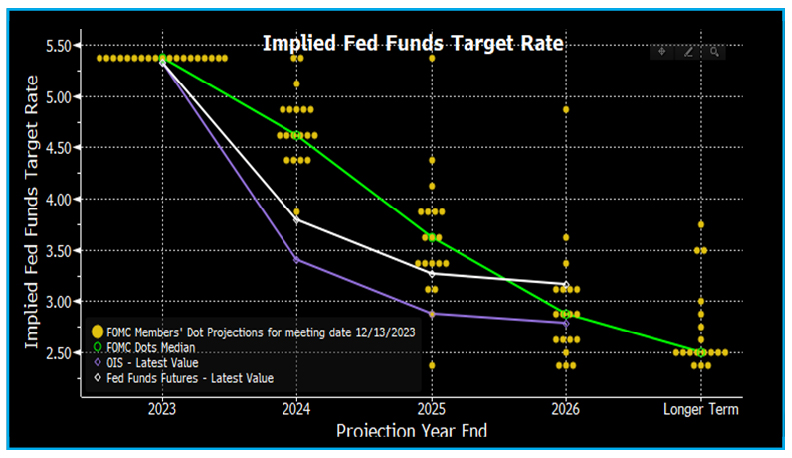
Source – Bloomberg, Data as of December 13, 2023
Yellow dots represent each FOMC members’ projection of future Fed Funds Rate; the green line shows the median estimate for the same.
Other major central banks are not as explicit in their commentaries. Instead, some pushed back on the rate cut calls; like the ECB President Christine Lagarde countered - “We should absolutely not lower our guard”. And the BOE governor, Andrew Bailey, observed that “there is still some way to go” in the fight against inflation.
Nevertheless, they also highlighted that the full effect of higher interest rates is yet to come through. Therefore, they must remain vigilant to financial stability risks that might arise.
Overall, the policy undertone has turned less hawkish or incrementally dovish across the board indicating the worst of rate hiking cycle is now behind us.
Back home, the RBI governor Shaktikanta Das, for the first time in the last two years, cautioned to the risk of overtightening the monetary policy.
He also noted – “We have now reached a stage when every action has to be thought through even more carefully to ensure overall macroeconomic and financial stability; more so, because the conditions ahead could be fickle.” This is a big shift from the RBI’s policy making with Arjuna’s eye on inflation.
At this stage, the RBI seems more worried about potential shocks to the financial system and the growth outlook from fragile external environment. This will probably tilt the RBI’s reaction function more towards global macro environment and monetary policy cycle.
So, even if domestic inflation remains above 4%, the RBI might cut interest rates in response to worsening of global economic or financial conditions. Nonetheless, inflation outlook too looks supportive for the monetary policy.
The Core Disinflation
India’s Inflation trajectory has improved tremendously over the last few months though it didn’t get much attention due to volatile and generally high food prices which kept the headline CPI inflation elevated for most part in 2023.
As per the latest data, the headline CPI inflation stands at 5.6% in November 2023. As per the RBI’s projections, headline CPI inflation is expected to average at 5.4% in the fiscal year 2023-24.
However, if we strip out the impact of food prices, inflation for other goods and services (CPI ex-Food) now stands at 3.6%. Another popular measure - the Core CPI inflation, which excludes the food and energy prices has come closer to the RBI’s 4% target and is expected to slide down further in 2024.
Chart – II: Falling Core Inflation (ex-Food and Fuel) to ease pressure from the RBI
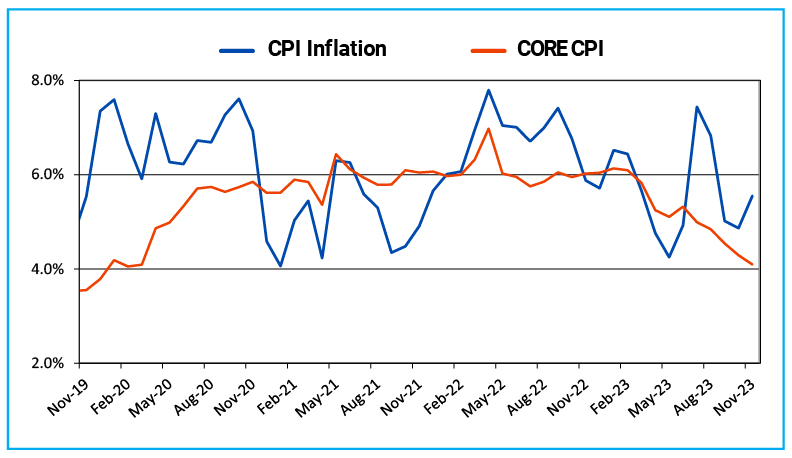
Source – MOSPI, Quantum Research, Data upto November 2023
Although the RBI’s target is based on headline CPI, it would draw comfort from falling core inflation which tends to be more sticky.
As far as food inflation is concerned, monetary policy has a limited role to play. In this regard, the RBI worries more about the second-round impact of food inflation – high food prices feeding into inflation expectation and pushing up prices of other goods and services.
A crucial point to note here is that despite elevated food inflation, inflation expectations of Indian households have been very well anchored. As per the RBI’s inflation expectation survey, households’ perception of current inflation and expectations of future inflation have been coming down consistently in 2023 except for a marginal uptick in the one year ahead inflation expectation in November.
Chart – III: Despite elevated food inflation, household inflation expectation is very well anchored
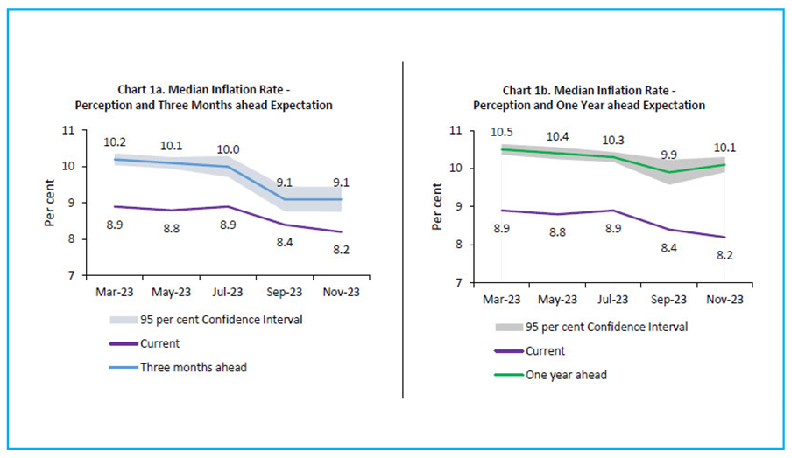
Source – RBI monetary policy document, December 2023
To put this in context, there is no sign of second round inflationary impact of high food prices on inflation expectation or prices of core goods and services.
Thus, the RBI should not be overly worried about food inflation at this point. Having said that, this doesn’t open room for rate cut by itself. If at all, the RBI needs to cut rates in 2024, that would probably come in response to financial or economic shock from the external world.
From the market’s perspective, falling core inflation should lower the inflation risk premium on bonds by reducing the yield spread on government bonds over the policy repo rate. This in turn can bring down the bond yields even without a rate cut by the RBI. Any increase in the rate cut probabilities would further intensify the downward trend in bond yields.
Falling Bond Supply
After expanding the fiscal deficit to 9.2% of GDP during pandemic shock in FY2020-21, the government has been on a path of fiscal consolidation. The government has set a target to bring down the fiscal deficit to under 4.5% of GDP by FY2025-26 from the budgeted 5.9% fiscal deficit target for FY 2023-24.
Assuming the government will stick to this fiscal plan, the net issuance of government bonds would decrease by around Rs. 1.6 trillion over the next 2 years.
Chart – IV: Fiscal consolidation will lead to significant reduction in bond supply over coming years
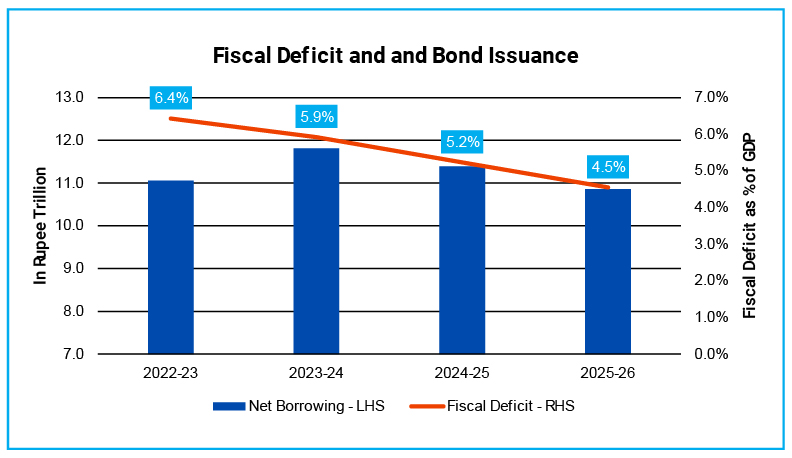
Source – IndianBudget.gov.in, Quantum Research, Data for FY25 and FY26 is based on Quantum Research team’s estimates
While on the demand side, a healthy growth trend observed in the assets of long-term investors like insurance, pensions, provident funds etc. is expected to continue in line with the growth in the nominal GDP. The demand for bonds can also be boosted by India’s inclusion in the global bond index.
We might see a situation where demand outpaces supply in the government bond market over the next two years.
Index Inclusion and foreign demand
India will be included in the JP Morgan GBI EM Index starting June 2024 with an eventual 10% index weight to be reached by March 2025. This is expected to attract USD 25-40 billion of foreign inflows into Indian bonds over the next 12-15 months. {Why Soaring Oil Prices Couldn't Dampen Market Mood}
More importantly, index inclusion can open a source of consistent demand for Indian bonds from investors who track the index, particularly from the exchange-traded funds or ETFs. Even active investors will be more comfortable investing in India when it becomes part of the index.
Apart from the direct impact of additional demand, there could be spill-over benefits as well -
• The new demand source for government bonds might also help in deepening the corporate bond market in India.
• Potential foreign inflows into Indian debt will expand the source of foreign capital which in turn will strengthen India’s balance of payment situation and deepen the market for the Indian Rupee.
• Foreign holding of bonds would enforce much stricter discipline on the fiscal and monetary policy.
• Increased participation by foreign investors, would enhance the credibility of the Indian bond market and will make it easier for the government and the corporate sector to raise debt capital from global investors.
So far in 2023, foreign investors (FPI) have been consistent buyer in the bond market with net purchase of Rs. 568 billion (USD 6.83 billion) of government bonds (data upto December 19, 2023). We expect the pace of foreign buying in Indian bonds to increase in 2024 with the global interest rate changing course.
Chart – V: Foreigners turned buyer in Indian bonds in 2023
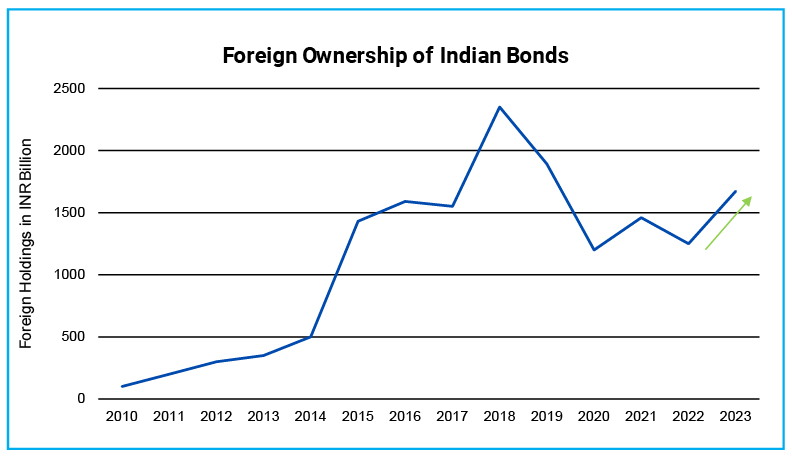
Source – RBI, Quantum Research, Data up to September 2023
What should Investors do?
With high starting yield and expectation of fall in bond yields, we believe that long term government bonds offer investor a rewarding opportunity.
Dynamic Bond Funds are probably best placed to capture this opportunity with a flexibility to change if things don’t pan out as expected. However, investors need to have a longer holding period of atleast 2-3 years to ride through the intermittent volatility.
Investors with shorter investment horizons and low-risk appetites should stick with liquid funds.
Portfolio Positioning
Scheme Name | Strategy |
The scheme invests in debt securities of up to 91 days of maturity issued by the government and selected public sector companies. | |
The scheme to invest in debt securities issued by the government and selected public sector companies. The scheme follows an active duration management strategy and increases/decreases the portfolio duration (sensitivity to interest rates changes) in accordance with the Interest Rate Outlook. Given sharp drop in yields, we have trimmed down the high duration position in the scheme. However, the scheme still carries relatively high portfolio duration reflective of our positive medium-term outlook. |
Source – RBI, Quantum Mutual Fund
For any queries directly linked to the insights and data shared in the newsletter, please reach out to the author – Pankaj Pathak, Fund Manager – Fixed Income at [email protected].
For all other queries, please contact Neeraj Kotian – Area Manager, Quantum AMC at [email protected] / [email protected] or call him on Tel: 9833289034
Read our last few Debt Market Observer write-ups -
- Geopolitics and Shifting Demand-Supply Balance
Name of the Scheme | This product is suitable for investors who are seeking* | Riskometer |
Quantum Liquid Fund An Open-ended Liquid Scheme. A relatively low interest rate risk and relatively low credit risk. |
| 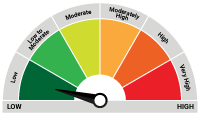 Investors understand that their principal will be at Low Risk |
Quantum Dynamic Bond Fund An Open-ended Dynamic Debt Scheme Investing Across Duration. A relatively high interest rate risk and relatively low credit risk. |
| 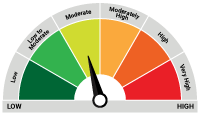 Investors understand that their principal will be at Moderate Risk |
* Investors should consult their financial advisers if in doubt about whether the product is suitable for them.
| Potential Risk Class Matrix – Quantum Dynamic Bond Fund | |||
Credit Risk → | Relatively Low | Moderate (Class B) | Relatively High (Class C) |
Interest Rate Risk↓ | |||
Relatively Low (Class I) | |||
| Moderate (Class II) | |||
| Relatively High (Class III) | A-III | ||
| Potential Risk Class Matrix – Quantum Liquid Fund | |||
Credit Risk → | Relatively Low | Moderate (Class B) | Relatively High (Class C) |
Interest Rate Risk↓ | |||
| Relatively Low (Class I) | A-I | ||
| Moderate (Class II) | |||
| Relatively High (Class III) | |||
Disclaimer, Statutory Details & Risk Factors:The views expressed here in this article / video are for general information and reading purpose only and do not constitute any guidelines and recommendations on any course of action to be followed by the reader. Quantum AMC / Quantum Mutual Fund is not guaranteeing / offering / communicating any indicative yield on investments made in the scheme(s). The views are not meant to serve as a professional guide / investment advice / intended to be an offer or solicitation for the purchase or sale of any financial product or instrument or mutual fund units for the reader. The article has been prepared on the basis of publicly available information, internally developed data and other sources believed to be reliable. Whilst no action has been solicited based upon the information provided herein, due care has been taken to ensure that the facts are accurate and views given are fair and reasonable as on date. Readers of this article should rely on information/data arising out of their own investigations and advised to seek independent professional advice and arrive at an informed decision before making any investments. Mutual fund investments are subject to market risks read all scheme related documents carefully. |
Related Posts
-

The Pivot
Posted On Friday, Apr 21, 2023
The fiscal year 2022-23 has come to an end. The defining feature
Read More -

Yield Curve Inversion Ahead
Posted On Thursday, Mar 23, 2023
Indian money markets have tightened meaningfully over the last one and a half month.
Read More -

Past, Present, and Future of Inflation
Posted On Friday, Feb 24, 2023
Inflation has been one of the biggest challenges in the post-pandemic world.
Read More




